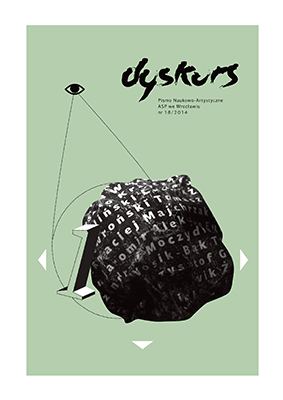Eseistyczne meandry wokół abstrakcji
Essayist meander around the abstraction
Author(s): Stefan CzyżewskiSubject(s): Philosophy
Published by: Akademia Sztuk Pięknych im. Eugeniusza Gepperta we Wrocławiu
Summary/Abstract: Part I. Pedigree of abstraction. The emergence of abstraction is the result of consistent course of different phenomena, beginning as early as the nineteenth century and preparing the ground for appearance of Kandynski and Malevich at the beginning of the first decade of the twentieth century. In the same time the existence of duality is connected with two forms of abstraction as a continuation of instances of those artists: forms of abstraction of ‘poetics of expression’ and forms of abstraction of ‘poetics geometry’. The opposition of figurative and abstract art is the result of common oversimplification, as well as the binding of its existence only with the twentieth century. Part II. The essence of abstraction. The analysis of the concept of abstraction leads to the disclosure of too narrowly understood importance of abstraction which doesn’t include the complexity of issues. The formulation of a broadened definition of abstraction is the result of the analysis. The definition includes the category of recipients and their competence to analyze the problems. It contributes to relativisation of the scope of understanding the concept, expanding its importance and opening the perspective for communication. The conclusive definition of abstraction is as follows: ‘Abstraction is everything that has no name and doesn’t exist as visual experience; specific sensations of substantial properties in images are not logical due to the lack of appropriate competencies which prevent the intelligible processes’. This perspective also means that, as formal indicator, abstraction does not belong strictly to images and is the sum of the perceptual effect, temporarily set for the recipient. The adoption of such a solution is connected with the acceptance of the liquidity of categories of both abstraction and realism. What has been recognized in the image and what was previously visually experienced – is real. Abstraction is everything that has no name and is not recognized by a person, because the person has no previous experience of what he/she sees. Visual experience and cultural competence, combined with the natural activity of our perception, enforce our ‘seeing with understanding’. Therefore knowledge, intellectual activity and experience are the keys to identifying and understanding images, leaving the relationship of images and the reality on a margin. Part III. Understanding abstraction. Based on the analysis, the two questions can be answered: 1) is abstract art really in opposition to figurative art? and 2) does abstract art is limited to contemporary art (of the 20th century)? There is a negative answer to the first question. It is based on the notion that abstract art and figurative art are not in opposition to each other, but rather, they are complementary and co-exist with each other. Abstract art and figurative art co-existed from the beginning of abstraction. There are different trends in both kinds of art and both undergo evolut
Journal: DYSKURS Pismo Naukowo-Artystyczne ASP we Wrocławiu
- Issue Year: 2014
- Issue No: 2 (18)
- Page Range: 6-55
- Page Count: 50
- Language: Polish

